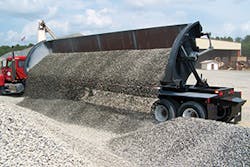The factors that go into making an appropriate selection from among the choices depend on job site needs and regulations.
Clement Industries offers a wide variety of steel and aluminum dump trailers for different operations, designed to be lightweight and durable. “On the steel side, we make everything from bottom dumps to end dumps to side dumps, both with high tensile steel and also with AR450 high-abrasion resistance steel,” says Greg Leong, president. “On the aluminum side, we have the extruded side panel aluminum models and also the sheet and post aluminum trailers on the end dump trailers.”
The factors that go into making an appropriate selection from among the choices depend on job site needs and regulations. Clement Industries offers a wide variety of steel and aluminum dump trailers for different operations, designed to be lightweight and durable. “On the steel side, we make everything from bottom dumps to end dumps to side dumps, both with high tensile steel and also with AR450 high-abrasion resistance steel,” says Greg Leong, president. “On the aluminum side, we have the extruded side panel aluminum models and also the sheet and post aluminum trailers on the end dump trailers.” [text_ad] Certain trailers lend themselves to specific materials. For instance, for large particle sizes and more abrasive loads, contractors look for trailers with thicker steel, says Paul Pickett, Clement Industries’ sales and marketing coordinator. “We build up to 5/16ths wear plate trailers, which will take a 2-ton boulder dropped on it with no damage. Aluminum trailers are more appropriate for sand and gravel applications,” he adds. Among the changes that Clement Industries is making to its trailers is a redesign of the top rails. “The top rails were being destroyed by grapples and we’ve changed that to limit the damage to the top rails,” notes Pickett. The company’s most recently-launched model is the PaveStar, designed for asphalt and light aggregate. Its body is constructed of a thinner-gauge AR material. It is designed for the right suspension heights to where it “matches completely” with other machines a contractor would be using, says Leong. The MonStar is made of quarter-inch AR450 and is designed for demolition and scrap hauling. It is 45 feet long and holds 99 cubic yards. “It’s called a MonStar for a reason,” says Leong. “It’s a massive trailer. At that demolition site where a grapple hook is grabbing big demolition material and dropping it in there, this trailer can handle that. “Likewise, we make a rock trailer which is a shorter-sided half-round trailer with a quarter-inch 450 material to handle up to big boulders that can be carried in it. For contractors who are wanting to haul rock, but not quite as extreme as big boulders, we make a 3/16th version of that AR material half-round.” The company’s bottom dumps are better suited to dirt handling, says Leong. Contractors like them because the material doesn’t go up in the air and the “inherent instability when it comes to doing that,” says Leong. “With the bottom dump trailer, the wheels are always on the ground and the material just drops out of a gate from the bottom,” he adds. “With the side dump trailers, all four wheels stay on the ground and you’re not going to the extreme heights—you’re tipping to the side. That’s crucial if you’re going down the side of a road and you want to dump on the side of a highway. You can actually dump that load while you’re still moving forward and dump along in a row with both gravel and dirt.” The popularity for side dumps is growing, particularly in the western US, notes Pickett. “A lot of folks like them for the stability—they feel they’re more stable than an end dump that raises way up in the air,” he says. “They don’t have the range of the capacity that end dumps have.” Contractors do like the convenience of side dumps when working on highway jobs on the edge of the road to dump materials right where they want it, points out Pickett. “It’s also made out of wear plate and will take large rocks with no problem,” he adds. Belly dumps are used primarily in construction and can spread material so that it doesn’t take as much grading in contrast to an end dump, which produces a more of a centralized pile of material, notes Pickett. Pup trailers complement dump trucks. “You can put a pin lock on your dump truck to pull a pup trailer and double your payload with a relatively small increase in fuel consumption,” says Pickett. The top factor to consider in making a material hauling choice is how much material can be hauled legally and efficiently, says Leong. “With a shortage of truck drivers, the high liability that goes along with running these trailers and trucks on the road, and the fuel costs that are associated with it—the more that you can haul legally, the better off you are,” he says, adding that was a driving factor in his company designing equipment that is light, yet durable. Being able to move more material in each individual load—for instance, 5% more—means reducing fuel, driver, and insurance costs by that much, says Leong. “Every time that trailer goes down the road, you need to make sure you’re maximizing your payload,” he adds.Certain trailers lend themselves to specific materials. For instance, for large particle sizes and more abrasive loads, contractors look for trailers with thicker steel, says Paul Pickett, Clement Industries’ sales and marketing coordinator.
“We build up to 5/16ths wear plate trailers, which will take a 2-ton boulder dropped on it with no damage. Aluminum trailers are more appropriate for sand and gravel applications,” he adds.
Among the changes that Clement Industries is making to its trailers is a redesign of the top rails.
“The top rails were being destroyed by grapples and we’ve changed that to limit the damage to the top rails,” notes Pickett.
The company’s most recently-launched model is the PaveStar, designed for asphalt and light aggregate. Its body is constructed of a thinner-gauge AR material. It is designed for the right suspension heights to where it “matches completely” with other machines a contractor would be using, says Leong.
The MonStar is made of quarter-inch AR450 and is designed for demolition and scrap hauling. It is 45 feet long and holds 99 cubic yards.
“It’s called a MonStar for a reason,” says Leong. “It’s a massive trailer. At that demolition site where a grapple hook is grabbing big demolition material and dropping it in there, this trailer can handle that.
“Likewise, we make a rock trailer which is a shorter-sided half-round trailer with a quarter-inch 450 material to handle up to big boulders that can be carried in it. For contractors who are wanting to haul rock, but not quite as extreme as big boulders, we make a 3/16th version of that AR material half-round.”
The company’s bottom dumps are better suited to dirt handling, says Leong. Contractors like them because the material doesn’t go up in the air and the “inherent instability when it comes to doing that,” says Leong.
“With the bottom dump trailer, the wheels are always on the ground and the material just drops out of a gate from the bottom,” he adds. “With the side dump trailers, all four wheels stay on the ground and you’re not going to the extreme heights—you’re tipping to the side. That’s crucial if you’re going down the side of a road and you want to dump on the side of a highway. You can actually dump that load while you’re still moving forward and dump along in a row with both gravel and dirt.”
The popularity for side dumps is growing, particularly in the western US, notes Pickett.
“A lot of folks like them for the stability—they feel they’re more stable than an end dump that raises way up in the air,” he says. “They don’t have the range of the capacity that end dumps have.”
Contractors do like the convenience of side dumps when working on highway jobs on the edge of the road to dump materials right where they want it, points out Pickett.
“It’s also made out of wear plate and will take large rocks with no problem,” he adds.
Belly dumps are used primarily in construction and can spread material so that it doesn’t take as much grading in contrast to an end dump, which produces a more of a centralized pile of material, notes Pickett.
Pup trailers complement dump trucks. “You can put a pin lock on your dump truck to pull a pup trailer and double your payload with a relatively small increase in fuel consumption,” says Pickett.
The top factor to consider in making a material hauling choice is how much material can be hauled legally and efficiently, says Leong.
“With a shortage of truck drivers, the high liability that goes along with running these trailers and trucks on the road, and the fuel costs that are associated with it—the more that you can haul legally, the better off you are,” he says, adding that was a driving factor in his company designing equipment that is light, yet durable.
Being able to move more material in each individual load—for instance, 5% more—means reducing fuel, driver, and insurance costs by that much, says Leong.
“Every time that trailer goes down the road, you need to make sure you’re maximizing your payload,” he adds.



